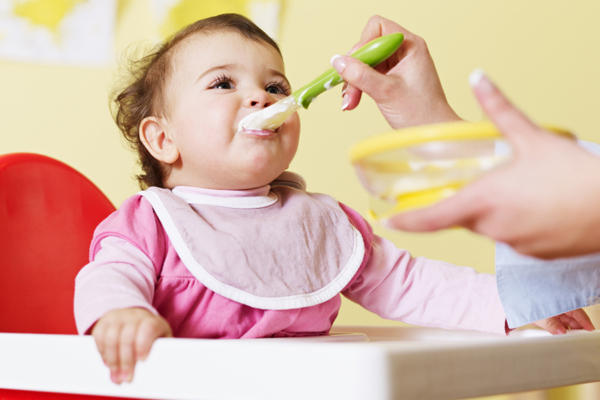Toddlers
can be picky eaters at the best of times, but if you’re worried that they’re
not getting enough food into their system, the problem might be how much they’re
drinking between meals.
“Excess
milk and juice consumption can negatively impact appetite, and it’s really very
common,” explains Brenda Bradshaw, author of The Baby’s Table. “Often, toddlers
are walking around drinking three bottles a day. That’s six cups of milk. You
can’t expect your toddler, if they’re drinking six cups of milk a day, to be
able to eat properly. During that toddler year they should go from drinking
three cups of milk on their first birthday to two cups by their second
birthday.”
Bradshaw
was first inspired to write The Baby’s Table, in collaboration with Lauren
Donaldson Bramley, M.D., back in 2004 upon recognizing the dearth of resources
for making baby food from scratch. The 2010 edition is filled with updated information
on breastfeeding, food allergies, nutrition, common problems parents run into, as well as more than 150 recipes. In a conversation with CityLine.ca
from her Vancouver
home, Bradshaw appears heartened by the fact that more people are now making
their own baby food.
“Why
would you buy a jar of banana for your baby when you can just mash a banana? I feel
strongly that making your own baby food facilitates an easier transition into
regular food,” she remarks. “If you’ve tried these jarred baby foods, they just
don’t taste that great. It’s like canned peas vs. fresh peas, you just can’t
compare.”
Bradshaw,
an elementary school teacher, has two children, a five-year-old daughter and a
12-year-old son, and while her daughter is a good eater, her son provided a
challenge.
“My son
was a lot pickier all the way through than my daughter,” she admits. “Some
children are, plain and simple, a little more difficult than others. And it’s
just perseverance, dedication to the program, and that’s how it was with my
son. He’s 12 years old now, and appetite kicks in. He’s turned into a great
eater, but it’s hard. I can empathize with parents that it is hard for. Perseverance,
dedication, keep the junk out of the house, it’s doing no one any favours.”
The revised
edition of The Baby’s Table takes into account Health Canada’s recommendation
that high-iron foods be introduced first to help combat iron deficiency anemia
in children aged six months to 24 months. So along with iron-fortified infant
cereals, finely minced meats can be introduced at this time, even before fruits
and vegetables.
“I’ve
made a very simple chicken puree, a very simple beef puree,” she notes. “We
thin the purees out with either breast milk, obviously that’s number one,
leftover cooking water, or formula if you are using formula. That makes it more
palatable for the baby.”
A common
fear among parents is that their child will develop a serious food allergy – and
while the predominant thinking used to be delaying the introduction of foods
considered an allergy risk, among them nuts, shellfish, and wheat, scientific
evidence suggests this has no bearing on whether a child will develop an
allergy.
“It’s
based on a genetic predisposition, so your child is considered at high risk for
allergies if either of the parents have allergies or the sibling has an
allergy. These aren’t just food allergies. It’s called atopic disease – if a
sibling or a parent has atopic disease, that’s allergies, eczema, asthma, if
you have any of those in your family you should be much more vigilant,”
Bradshaw says. “And if you have severe allergies in your family, you should
probably talk to your health care professional before introducing foods that
are considered potential allergies.”
Bradshaw
muses that over the years we’ve made feeding our children a more complicated
issue than it needs to be.
“We’re
panicked about our babies, and our toddlers, and our pre-schoolers and they’re
not eating enough so we’re pressuring them to eat. On the other hand we have this
childhood obesity epidemic,” she says. “What we need to do is raise a child who
can listen to his or her bodily cues — stop eating when they’re full, and eat
when they’re hungry. The best way to do that is to let your child choose what
they eat, and when I say choose what they eat, I mean: you put healthy food at
the dinner table, put a few portions on their plate. They decide what they eat,
and you, hands off. If they’re full, let it go.”
Thinking
of making your own baby food? Here are the tools you need:
-Ice cube
tray, metal if possible, to freeze portions. If not, make sure food has cooled
down before you pour it into a plastic ice cube tray (you don’t want anything
leaching out of the plastic into the food)
-Blender
or food processor — hand-held immersion blenders are great
-Steamer
baskets for steaming vegetables
-Muffin
tins to freeze food in, as babies get older and are eating larger portions
-Freezer
bags or reusable containers to pop the frozen portions in
Baby food
keeps for about a month in the freezer.
Chicken Apple Delight
This is a great way to introduce chicken to an applesauce lover.
2 sweet apples, washed, peeled and quartered
1/2 chicken breast, poached
2 tbsp unsweetened apple juice or leftover poaching water
In steamer, steam apples over boiling water for 10 minutes
In blender or food processor, puree chicken, apples, and unsweetened apple juice to achieve desired consistency. If the puree seems too thick, add a little more apple juice as needed.
Pour into ice cube trays and freeze.
Yield: 10 cubes
Recipe courtesy The Baby’s Table, Brenda Bradshaw and Lauren Donaldson Bramley, M.D., Random House of Canada, Ltd., 2010

